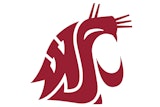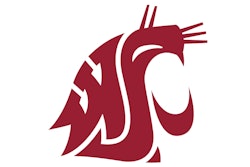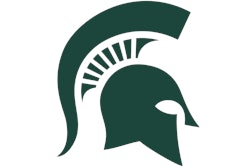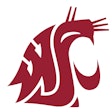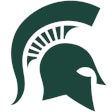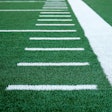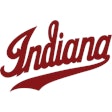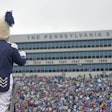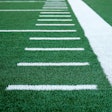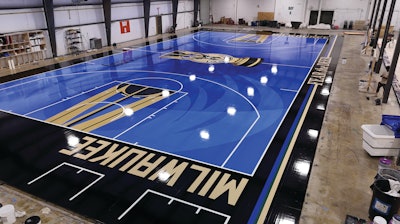
Before the clock could count down to zero during the 2024 Emirates NBA Cup Championship game, the Milwaukee Bucks were celebrating. With a 16-point lead comfortably in their favor, the 2021 NBA Champions took to center court with their coaches and raised the Emirates Cup trophy with pride.
It was a strong ending to a hard-fought in-season tournament, but the real work to pull off the 67-game contest began months before the players ever took to the court.
In the Northwoods of Wisconsin, a tree was felled that would soon be processed, trimmed and sanded into the bare bones of one of the Emirates NBA Cup courts. That lumber then traveled from its original home in Wisconsin to the manufacturing floor in Ohio to the design and painting plant in Chattanooga, Tenn., and ultimately to T-Mobile Arena in Las Vegas for the championship game.
This process was repeated for all 30 portable basketball courts, each of them painted with a team’s custom design and shipped around the country before the tournament began Nov. 12. The Bucks may have been the team holding up the trophy in the end, but three companies — Robbins Sports Surfaces, Praters Flooring and Bona — were also celebrating at the feat it was to fill the largest order of sports courts in the history of basketball.
 Photo courtesy of Robbins Sports Surfaces
Photo courtesy of Robbins Sports Surfaces
Getting the call
Prior to the Emirates NBA Cup, NBA franchises and arenas handled courts individually. The NBA provided a list of preferred vendors, but there were dozens of companies to choose from when it came to implementing the court designs. Each team had one or two courts, a classic and a city edition that matched team jerseys, and the look and finish of each court could vary from team to team.
While Bona had been a longtime partner of the NBA, both Robbins and Praters developed relationships with the organization more recently.
“We first started talking to the NBA in 2017, and over the past couple of years, our relationship has really blossomed,” says Mark Frainie, chief operating officer at Praters, a company that designs and installs portable courts.
Bill Price Jr., director of athletic surfaces at Bona, can also remember the early days of his company’s partnership with the league. “We’ve had a relationship with the NBA for 14 years now, and we have acted as a consultant and offered guidance to the NBA during all that time,” Price says. “They came to us 12 years ago and said they wanted to standardize all the team courts.”
In 2023, when the NBA announced what was then called the “in-season tournament,” logistics planning had been going on in the background for quite some time. After all, if the organization’s full vision came to life, it would require a custom portable court for every single NBA team plus the championship game’s host facility. John Ficks, global sales manager at Robbins remembers getting the call. “The NBA said, ‘Okay, we need to buy 30 portable basketball floors.’ That was a huge deal. Up until that point, we were doing 15 courts per year, all custom-made.
“This was the first time that the NBA went out and said, ‘We’re going to buy these courts and supply them to the arenas.’ ”
Christopher Arena, head of on-court and brand partnerships at the NBA, says that the organization was looking to take advantage of an opportunity unique to basketball. “Basketball is the only sport that can do this. They aren’t colored grass fields for football or baseball. Hockey ice is white,” Arena says. “It was an easier process than you would think. Robbins was already working with 16 teams.”
“It’s a way to have a whole set of games during the year that brings excitement and fan participation,” says Praters Flooring founder John Prater. “The unique playing surface during this Emirates Cup tournament is branded and it keeps it top of mind. We want people clicking on the TV to stop and know that it is an Emirates Cup game.”
The designs that the NBA ultimately selected came from artist Victor Solomon. The courts are all fully painted with one base color and several overlapping circles. Center court is adorned with each home team’s logo, and the space directly underneath the basket is decorated with the image of the cup trophy.
“This is a scope of work that has never been done before,” Prater says, “to provide 30 portable basketball courts that are very complicated – the most complicated courts out there.”
And he wasn’t the only one impressed by the sheer amount of work to be done between the three companies. Says Ficks, “This was probably the largest purchase order that has ever been placed in the sports flooring industry.”
 Photo courtesy of Robbins Sports Surfaces
Photo courtesy of Robbins Sports Surfaces
Cutting down trees
It all starts in the Northwoods of Wisconsin and Michigan, where Robbins harvests trees for lumber. From harvesting to manufacturing, Robbins needed to hire more people to dramatically ramp up its production process.
“We went from being able to produce one new floor every three weeks to producing one new floor every week,” says Ficks, adding that production speed was necessary if Robbins was going to create 30 Emerates NBA Cup courts on top of maintaining their normal business, which includes industry leaders such as the NCAA and college recreation groups. “It forced the entire industry to up their game and figure out how to effectively meet the needs of a larger client base and tackle significant logistics issues that we had never addressed before.”
Robbins’ facility was packed with lumber for these courts. Sections were assembled across the production floor, and towers of portable court pieces were stacked and waiting to go to the next step of the process. “We manufacture a court that’s built but not sanded, sealed, striped or finished,” says Kevin Price, regional manager of Robbins Floors. “We present that to Praters. They sand, seal, stripe and finish the court using Bona’s products.”
 Photo courtesy of Praters Flooring
Photo courtesy of Praters Flooring
Creating the paint
While the team at Robbins was hard at work in the Northwoods, Bill Price and his team at Bona were burning the midnight oil in the chemistry lab to create the paints, coatings and maintenance products used on the courts. “We created 160 different paint colors, stain colors and glaze colors. That’s a massive undertaking by our lab workers to create those colors and communicate with the NBA for approval,” Bill Price says.
Collaboration with the NBA was essential because, as Arena explains, “Courts are a part of the marketing and fan experience, and they are color-matched with jerseys.”
Bona has worked with the NBA for over a decade, so the team was familiar with much of the work that it took to create the paint and stain colors for the Emirates NBA Cup courts, but the volume of work was unprecedented. “We produced between 75 and 80 gallons of paint for each cup court,” Bill Price says. “A regular, main NBA team court uses between 20 and 30 gallons of paint, depending on the design. So, it’s a big undertaking from a production standpoint.”
That massive amount of paint was necessary to create the artist’s court design, an expanse of saturated color that catches viewers’ attention from the moment they see it. “Victor Solomon has submitted a lot of different designs, and when that final design is chosen, it will be up to Bona to figure out how to produce the necessary colors,” says Bill Price.
 Photo courtesy of Robbins Sports Surfaces
Photo courtesy of Robbins Sports Surfaces
Bringing it all together
The team at Praters was responsible for combining the high-quality materials from Robbins with the paint and other products from Bona into the iconic courts seen on TV and in arenas across the country.
“We can put down nine courts at a time, and starting in June we were sanding, painting and finishing courts,” Frainie says. “When we started, it took us four or five weeks to finish a court, but by the end of it we had them down to about three weeks.”
John Prater started Praters Flooring in the 1990s, back when putting a custom design or logo on a court was a major differentiator for his business. “Back then, when you put in a basketball court, there was no branding,” he says. “It was just game lines and maybe some Helvetica font letters but that was about it.”
Despite the fact Praters has installed portable courts since 2004, the Emirates NBA Cup job was still a challenge for the Chattanooga, Tenn.-based company. “It took buy-in from everybody at Praters,” Prater says, noting that, like Robbins, he had to hire several additional hands to deliver on the court project. “We don’t just put in a gym floor. We put in a gym floor and make it look pretty.
“We see our work every night on TV, and we use that as a source of pride and we celebrate that. It’s quite the accomplishment.”
 Photo courtesy of Praters Flooring
Photo courtesy of Praters Flooring
Starting from scratch
With two years of the in-season tournament successfully in the rearview mirror, the NBA, Robbins, Praters and Bona can now all look to the future, as work on the court project is far from over.
Says Kevin Price, “Every year, those 30 courts will all be sanded down to bare wood and repainted going into the next year’s tournament. Every four years, the teams will get whole new courts.”
For an ordinary portable court, Kevin Price says, a facility operator can expect to refinish the court every four years. He notes that typically a court can be sanded four times before it has reached the end of its lifespan, making most courts last a total of 12 to 16 years.
“It is unusual that the Emirates NBA Cup courts are being sanded every year,” Kevin Price says. “But, understanding the purpose of the tournament and the purpose of the floors, it makes perfect sense.”
For Bona, the hard work in the lab will not be repeated until a team has a color change or the artist, Victor Solomon, introduces completely new artwork for the courts. “We won’t have to do anything of that magnitude for the next few years or until something changes with the color,” Bill Price says.
Work has already begun on the 2025 Emirates NBA Cup courts. Arena from the NBA explains, “We just got the approval for the 2025 design today [Feb. 25], there will be 30 days to go back and forth with the teams, and design approval is due on April 1 for Praters to get started with paints and stains.”
This time around, the teams at Praters and Robbins are glad to be starting even earlier on the courts than the previous year’s timeline. And this annual process will continue for as long as the Emirates NBA Cup continues to capture the attention of basketball fans across the country.
“The Emirates NBA Cup courts project is epic,” Ficks says. “It’s a piece of art that they play basketball on, and it is designed for the safety and comfort of every athlete who uses it.”














